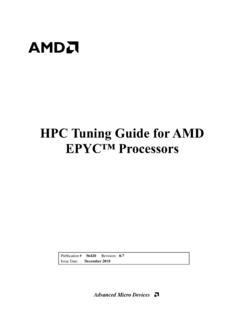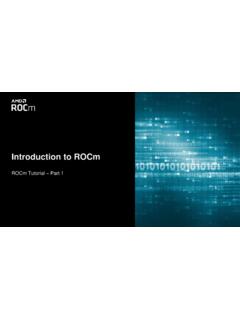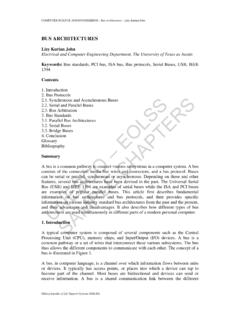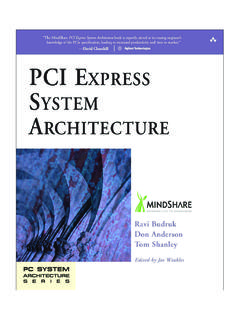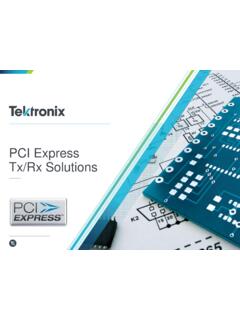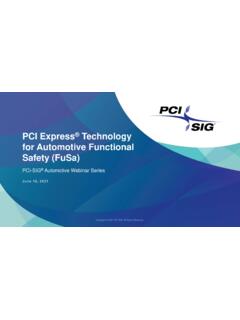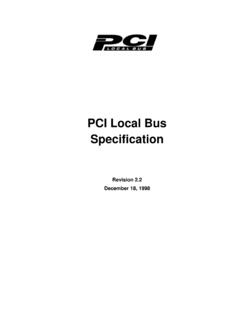Transcription of PCI/PCI Express Configuration Space Access
1 2008 Advanced Micro Devices Inc Page 1 of 7 PCI/PCI Express Configuration Space Access Advanced Micro Devices, Inc. May 2008 1. Introduction PCI devices have a set of registers referred to as Configuration Space and PCI Express introduces Extended Configuration Space for devices. Configuration Space registers are mapped to memory locations. Device drivers and diagnostic software must Access the Configuration spaces and operating systems have APIs to allow Access to device Configuration Space . When the operating system does not have Access methods defined or APIs for memory mapped Configuration Space requests, the driver or diagnostic software has the burden to Access the Configuration Space in a manner that is compatible with the operating system underlying Access rules.
2 In all systems, device drives are encouraged to use APIs provided by the operating system to Access the Configuration Space of the device. For systems that do not implement a processor- architecture specific firmware interface standard that allows Access to Configuration Space , PCI Express defines an Enhanced Configuration Access mechanism (ECAM). This whitepaper outlines the best coding practices for device drivers and diagnostic software developers to use, when accessing PCI/PCI Express Configuration Space . Separate sections are provided for Windows, Solaris, and Linux operating systems.
3 2008 Advanced Micro Devices Inc Page 2 of 7 PCI/PCI Express Configuration Space Memory Map o 4K/func/dev, 256MB per bus o Flat memory mapped Access o Firmware indicates memory base o First 256 bytes PCI compatible o Do not assume CF8/CFC available for extended Space Access 2. Windows Operating System Windows Overview In Windows, Access is facilitated for drivers which are part of the driver stack which owns the Configuration Space . Configuration Space Access has been provided in a uniform way since the Windows 2000 product was introduced. Complete information is contained in the following KB article.
4 PPCCII EExxpprreessss EExxtteennddeedd CCoonnffiigguurraattiioonn SSppaaccee PPCCII CCoonnffiigguurraattiioonn SSppaaccee ((ccuurrrreennttllyy aavvaaiillaabbllee tthhrroouugghh CCFF88//CCFFCC)) RReesstt ooff EExxtteennddeedd CCoonnffiigguurraattiioonn SSppaaccee ffoorr PPCCII EExxpprreessss PPaarraammeetteerrss CCaappaabbiilliittiieess 00 00xx110000 00xx11000000 PPCCII CCoommppaattiibbllee CCoonnffiigguurraattiioonn HHeeaaddeerr 00xx4400 PPCCII EExxpprreessss EExxtteennddeedd CCaapp SSttrruuccttuurree ((ssttaarrtt aatt 110000hh)) PPCCII EExxpprreessss CCaappaabbiilliittyy SSttrruuccttuurree ((BBaassiicc CCoonnffiigg RReegg)) 2008 Advanced Micro Devices Inc Page 3 of 7 Coding practices To Access Configuration Space a PnP I/O Request Packet (IRP) is sent from an in-stack driver at passive level.
5 This writes or reads a buffer of data at a specified offset. Parameters for the call are set up as follows: irpStack = IoGetNextIrpStackLocation( irp ); if (ReadOrWrite == 0) { irpStack->MinorFunction = IRP_MN_READ_CONFIG; } else { irpStack->MinorFunction = IRP_MN_WRITE_CONFIG; } irpStack-> =PCI_WHICHSPACE_CONFIG; irpStack-> = Buffer; irpStack-> = Offset; irpStack-> = Length; After the call, in the case of a read operation the data will be in the specified buffer area. Windows Vista and Windows Server 2008 Extended Configuration Space Access is provided in Vista and subsequent operating systems.
6 The Access method (PnP IRP) has been modified to cover the extended Configuration Space so the driver writers have the same interface as before. 3. Linux Linux Overview The Linux PCI subsystem provides a bunch of functions for PCI Configuration Space Access . pci_{read,write}_config_byte() pci_{read,write}_config_word() pci_{read,write}_config_dword() These functions read or write data of byte-, word- or double-word-size from or to PCI Configuration Space . In the end, the kernel decides which Configuration Space Access method (IO or MMIO) is used.
7 Coding practices This code snippet demonstrates how a device driver can use some of the functions mentioned above to Access the Configuration Space of a PCI device. void foo(struct device *dev) { struct pci_dev *pdev = to_pci_dev(dev); u8 rega; u32 regb; .. pci_read_config_byte(pdev, REG_FOO_1, pci_read_config_dword(pdev, REG_FOO_2, 2008 Advanced Micro Devices Inc Page 4 of 7 .. pci_write_config_word(pdev, REG_FOO_3, 0x0815); .. } MMIO Access with different Linux Kernel versions Support for MMIO Access for PCI Configuration Space depends on the Linux Kernel version and Configuration , and the existence of an MCFG ACPI table.))
8 IO Access to PCI Configuration Space is always possible and will be used if MMIO Access is not available. To Access extended Configuration Space (between byte 256 and 4095) MMIO Access is required. To enable the MMIO Access method you have to enable the following kernel Configuration options. For ARCH=x86_64 on all recent kernel versions (at least versions later than and including ) CONFIG_PCI_MMCONFIG "Bus options"->"PCI support"->"Support mmconfig PCI config Space Access " For ARCH=i386 and kernel versions later than and including version CONFIG_PCI_MMCONFIG "Bus options"->"PCI support"->"Support mmconfig PCI config Space Access " For ARCH=i386 and kernel versions prior to and including (at least down to )
9 CONFIG_PCI_GOMMCONFIG or CONFIG_PCI_GOANY "Bus options"->"PCI support"->"PCI Access mode"->"MMConfig" or "Bus options"->"PCI support"->"PCI Access mode"->"Any" Note: In both cases Linux supports the IO Access method as a fallback if MMIO Access is not possible ( if MCFG ACPI table is missing). A kernel (with version prior to and including ) with enabled MMIO Access method is able to do MMIO Access if and only if the BIOS provides a valid MCFG ACPI table and if the Configuration Space is "E820-reserved". If these requirements are not met, IO Access is used and the kernel logs an error message like this PCI: BIOS Bug: MCFG area at e0000000 is not E820-reserved PCI: Not using MMCONFIG.
10 PCI: Using Configuration type 1 Beginning with kernel version Linux always uses the IO Access method to Access Configuration Space below byte 256. Thus MMIO Access is used only for extended Configuration Space . 2008 Advanced Micro Devices Inc Page 5 of 7 For upcoming kernels the following changes are pending: o The restriction that Configuration Space must be "E820-reserved" will partially be lifted. o For AMD family 10h CPUs, MMIO Access will also work without an MCFG ACPI table as long as MSR C001_0058 (the MMIO Configuration Base Address Register) is properly configured.

